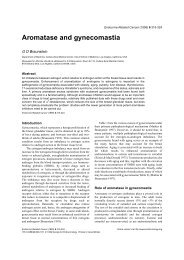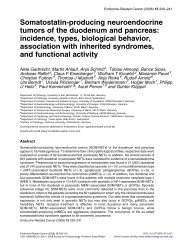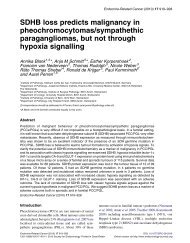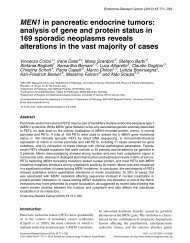Management of risk of breast carcinoma in postmenopausal women
Management of risk of breast carcinoma in postmenopausal women
Management of risk of breast carcinoma in postmenopausal women
You also want an ePaper? Increase the reach of your titles
YUMPU automatically turns print PDFs into web optimized ePapers that Google loves.
Biglia et al.: Breast <strong>carc<strong>in</strong>oma</strong> <strong>in</strong> <strong>postmenopausal</strong> <strong>women</strong><br />
Risk factors<br />
The ma<strong>in</strong> <strong>risk</strong> factors for <strong>breast</strong> cancer are listed <strong>in</strong> Table<br />
1.<br />
Age<br />
Age is the ma<strong>in</strong> <strong>risk</strong> factor for <strong>breast</strong> <strong>carc<strong>in</strong>oma</strong>. The<br />
<strong>in</strong>cidence <strong>of</strong> the disease <strong>in</strong>creases steadily from 29 up to<br />
40–50 years <strong>of</strong> age; after the menopause, the <strong>risk</strong><br />
cont<strong>in</strong>ues to rise up to 75 years <strong>of</strong> age <strong>in</strong> the USA and<br />
<strong>in</strong> northern Europe, while <strong>in</strong> Japan there is a slow<br />
decrease <strong>of</strong> <strong>in</strong>cidence after 45 years (Hulka & Moorman<br />
2001). Multiple factors such as genetic susceptibility,<br />
differences <strong>in</strong> endogenous hormonal levels, lifestyle and<br />
dietary factors, hormone therapy and availability <strong>of</strong><br />
mammography screen<strong>in</strong>g programmes can expla<strong>in</strong> the<br />
variations observed <strong>in</strong> different countries (Fig. 1).<br />
Family history<br />
Family history <strong>of</strong> <strong>breast</strong> cancer is another important <strong>risk</strong><br />
factor. Hav<strong>in</strong>g a mother or a sister with <strong>breast</strong> cancer<br />
<strong>in</strong>creases the <strong>risk</strong> <strong>of</strong> develop<strong>in</strong>g the disease by 2 to 3 times.<br />
If there is more than one affected relative, if the disease<br />
appears at a young age and if it is bilateral or associated<br />
with ovarian cancer, the <strong>risk</strong> <strong>in</strong>creases further (Thompson<br />
1994). Studies on families with high <strong>breast</strong> cancer<br />
<strong>in</strong>cidence have shown that about 5–7% <strong>of</strong> all <strong>breast</strong><br />
<strong>carc<strong>in</strong>oma</strong>s are hereditary. It was previously thought that<br />
mutations <strong>of</strong> two genes, <strong>breast</strong> cancer 1 (BRCA1) and<br />
BRCA2, were associated with a 90% lifetime <strong>risk</strong> <strong>of</strong><br />
develop<strong>in</strong>g the disease. Further population studies have<br />
shown that variants <strong>of</strong> these two genes have different<br />
penetrance. It is currently believed that <strong>women</strong> who are<br />
carriers <strong>of</strong> BRCA1 and BRCA2 mutations have a 37–<br />
85% cumulative <strong>risk</strong> <strong>of</strong> develop<strong>in</strong>g <strong>breast</strong> cancer before<br />
70 years <strong>of</strong> age, as compared with a <strong>risk</strong> <strong>of</strong> 10% for the<br />
general population (Easton et al. 1993, Struew<strong>in</strong>g et al.<br />
1996, Fodor et al. 1998). BRCA-related tumors generally<br />
appear before 50 years <strong>of</strong> age, although it is not unusual<br />
Table 1 Risk factors for <strong>breast</strong> cancer (modified from Hulka & Moorman 2001).<br />
to see patients diagnosed at a later age (Hulka &<br />
Moorman 2001).<br />
Mammographic density<br />
RR> 4 RR 2–4 RR 75% <strong>of</strong> dense <strong>breast</strong> at mammography High bone density<br />
RR, relative <strong>risk</strong>.<br />
Lifestyle (smok<strong>in</strong>g, physical activity)<br />
70 www.endocr<strong>in</strong>ology.org






